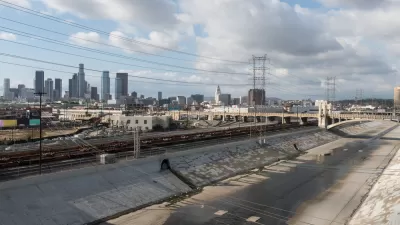With the dissolution of California Redevelopment Agencies in 2011, those looking to spur economic development have struggled to find alternative tools that create investment in communities where such investments don't flow naturally.
Senate Bill 628, passed in the fall, created Enhanced Infrastructure Financing Districts—intended to fill the "hole" that dissolution left. Since EIFDs are still brand new, none have yet been implemented, although many local governments have taken initial steps.
To unpack the law's complexities, its applications, and its potential impact on revitalization efforts across the state, The Planning Report spoke with two experts on the legislation: Fred Silva, Senior Fiscal Policy Advisor at California Forward, and Mark Pisano, USC Price professor and former Southern California Association of Governments executive director. They delve into the specific mechanisms of EIFDs, explaining the tool’s scope, structure, and powers.
Silva clarifies that EIFDs actually improve upon the old model, in his view: "After the repeal of redevelopment, the tool of capturing growth in the property tax was basically eliminated. The choice facing the Economic Summit was: 'Should we just put that Redevelopment Authority back, and not allow it to have access to the schools’ property tax?' The answer was 'no'—it should have broader authority."
FULL STORY: A New Tool for Urban Economic Development: EIFDs Demystified

Trump Administration Could Effectively End Housing Voucher Program
Federal officials are eyeing major cuts to the Section 8 program that helps millions of low-income households pay rent.

Planetizen Federal Action Tracker
A weekly monitor of how Trump’s orders and actions are impacting planners and planning in America.

Ken Jennings Launches Transit Web Series
The Jeopardy champ wants you to ride public transit.

Driving Equity and Clean Air: California Invests in Greener School Transportation
California has awarded $500 million to fund 1,000 zero-emission school buses and chargers for educational agencies as part of its effort to reduce pollution, improve student health, and accelerate the transition to clean transportation.

Congress Moves to End Reconnecting Communities and Related Grants
The House Transportation and Infrastructure Committee moved to rescind funding for the Neighborhood Equity and Access program, which funds highway removals, freeway caps, transit projects, pedestrian infrastructure, and more.

From Throughway to Public Space: Taking Back the American Street
How the Covid-19 pandemic taught us new ways to reclaim city streets from cars.
Urban Design for Planners 1: Software Tools
This six-course series explores essential urban design concepts using open source software and equips planners with the tools they need to participate fully in the urban design process.
Planning for Universal Design
Learn the tools for implementing Universal Design in planning regulations.
Heyer Gruel & Associates PA
Ada County Highway District
Institute for Housing and Urban Development Studies (IHS)
City of Grandview
Harvard GSD Executive Education
Toledo-Lucas County Plan Commissions
Salt Lake City
NYU Wagner Graduate School of Public Service



























